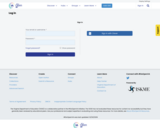
This resource provides a prompt for every school day that could be used to inspire students to express themselves in the language through speaking and/or writing
- Subject:
- Spanish
- World Languages
- Material Type:
- Activity/Lab
- Date Added:
- 02/11/2020

This resource provides a prompt for every school day that could be used to inspire students to express themselves in the language through speaking and/or writing
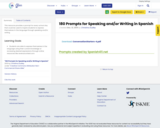
This resource provides a prompt for every school day that could be used to inspire students to express themselves in the language through speaking and/or writing
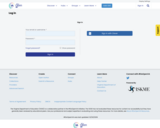
This resource provides a prompt for every school day that could be used to inspire students to express themselves in the language through speaking and/or writing
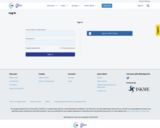
This resource provides a prompt for every school day that could be used to inspire students to express themselves in the language through speaking and/or writing
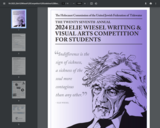
The annual Elie Wiesel Writing and Visuals Arts Competition is open to students in grades 6 through 12 and serves to inspire middle and high school students and teachers to learn more about the Holocaust, racism, bigotry, and the dangers of prejudice. The questions posed each year guide students to explore the lessons of the Holocaust while examining contemporary issues such as bullying, peer pressure, unthinking obedience to authority, and indifference.

This resource is a comprehensive unit of instruction created and piloted by the ACSE Region III team over the 2022-23 school year. This unit, which is accessible through multiple links to include worksheets, slidedecks, teacher suggestions and planning documents, includes all components of the instruction with SOL connections and is intended to join Computer Science standards to an ELA content area.

This is a cross-curricular activity that uses the story Alexander, Who Used to Be Rich Last Sunday to practice money and decimal skills in addition to reading and writing skills. After reading or hearing the story, students will complete the attached worksheet. (If it's read aloud, students would need a way to refer back to the story to answer the questions. The worksheet has a mixture of reading and math questions. It can be edited if you choose. It can be used for either 3rd or 4th grade. With slight modifications, it could also be used for middle school EL students to learn about currency.
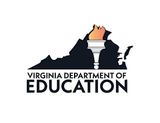
English Instruction Plan – Allusions and Figurative Language
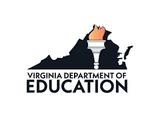
English Instructional Plan-Analyzing and Planning Persuasive Writing 7-8
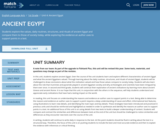
In this unit, students explore ancient Egypt. Over the course of the unit students learn and explore different characteristics of ancient Egypt and what the ancient Egyptians valued. Through learning about the daily routines, structures, and rituals of ancient Egypt, students will be challenged to draw conclusions about what the civilization valued and how those values compare to society today. Students will also learn about the role that mummies and pyramids played in ancient Egyptian society and why archeologists and scientists have been intrigued by them ever since. In second and third grade, students will continue their exploration of ancient civilizations by learning more about ancient Greece and ancient Rome. It is our hope that this unit, in conjunction with the others in the sequence, will help students understand and appreciate early civilizations that have had a lasting impact on the world.
In reading, this unit focuses on understanding the reasons and evidence an author uses to support points in a text. Being able to determine the reasons and evidence an author uses to support a point requires a deep understanding of cause and effect, informational text features, using illustrations to learn new details, and identifying the main topic and key details. These strategies have been introduced and practiced in previous units and should be reinforced and highlighted as needed in order to synthesize and identify the reasons an author uses to support points in a text. An additional focus of this unit is on using details from two texts to build a deeper understanding of content. Students will compare and contrast the similarities and differences between texts at the end of the unit but should be challenged to notice similarities and differences as they encounter new texts over the course of the unit.
In writing, students will continue to write daily in response to the text. At this point students should be fluid in writing about the text in a structured way. Therefore, the focus of this unit is on pushing students to include the best and most accurate evidence and then to explain the evidence with inferences or critical thinking.

In this science-based unit, students begin their exploration of animals and animal adaptations. Using next generation science standards as a guide, students explore three main topics: how different animals use their body parts and senses in different ways in order to survive, the ways in which the behavior of different animal parents and offspring help the offspring survive, and the similarities and differences among individual animals of the same kind. This unit is part of a larger progression on understanding animals and the animal kingdom. In kindergarten, students learn about how animals meet their basic needs for survival and how that varies depending on the season. In second grade, students learn about different habitats and how animals in the habitat rely on the environment for survival. Then in third grade, students study animal adaptations and the different ways animals adapt in order to survive, especially when threatened by environmental changes. It is our hope that this unit, in combination with others in the sequence, will help students develop a deeper understanding of the animal kingdom and life science.
This unit includes a mix of read-aloud texts and shared-reading texts. Students will focus on different skills depending on the method in which the text is consumed. During read aloud, students will refine their skills in describing the connection between ideas and pieces of information, figuring out the meaning of unknown words, distinguishing between information provided by the pictures and information in the text, and identifying the reasons an author gives to support points in a text. During shared reading, students will predominately focus on identifying the main topic of a section of a text, retelling key details that match the main topic, and using text features to locate key facts and information. Because the shared reading days are meant to be student driven, not teacher driven, the target tasks are at a more accessible, independent level for students. There are also not a lot of key questions already planned for shared reading days. Questions should be written and spiraled in based on student needs and student reading levels.
In writing, this unit builds on the work students did in unit one. Students will continue to write daily in response to the text, with a focus on correctly answering questions and adding an inference or critical thinking.
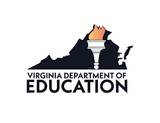
English Instructional Plan – Argumentation Editorial Concerning a Current Social/Health Issue
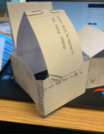
Students practice argumentative writing by building a house to show a strong thesis, reasons, and examples.
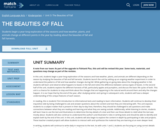
In this unit, students begin a year-long exploration of the seasons and how weather, plants, and animals are different depending on the season by studying the beauties of fall and fall harvests. Students launch the unit by setting up an ongoing weather experiment in order to understand the patterns of fall and how weather changes during fall. While gathering on-going data about the changing weather in fall, students will learn and observe what happens to leaves in the fall and notice the difference between various types of leaves. In the second half of the unit, students explore the different harvests of fall, particularly apples and pumpkins, and discuss the basic life cycles of both. This unit is a chance for students to stop and think about the changes that are happening in the natural world around them and why the changes happen. It is our hope that by the end of the year, after studying winter and spring in subsequent units, students will have a deeper understanding of the unique features of each season.
In reading, this is students' first introduction to informational texts and reading to learn information. Students will continue to develop their inquisitive side by being challenged to ask and answer questions about the content and text they are interacting with. This unit exposes students to a subject matter that is present in their day-to-day lives; therefore, they should be challenged to ask questions and make connections between what they are reading and learning and what they are seeing outside. Additionally, while listening to stories, students will learn how to use the text and illustrations to determine the key details of a text and then use those details to retell what the text was mostly about. Students will also continue to understand the author's and illustrator's roles in writing texts and should be able to identify and explain both by the end of the unit. In this unit, students will also begin to explore the content in-depth by participating in labs and projects. These teacher-created projects will allow students to interact with and synthesize the material they are learning at an even deeper level.
In writing, students will continue to write daily in response to the text. As with units 1 and 2, students are focusing on using correct details from the text to answer the question. Students should be using a combination of words and pictures, depending on the student's development as a writer. Daily teaching points, based on student data, should be included to ensure that students are progressing as writers.
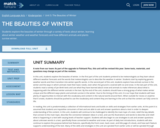
In this unit, students explore the beauties of winter. In the first part of the unit students pretend to be meteorologists as they learn about different weather forecasts and the words that meteorologists use to describe the weather in winter. Students start by exploring generic weather words and then transition into winter-specific words. In the second part of the unit, students explore how animals survive in the winter and the ways in which animals meet their basic needs, even when the ground is covered with ice and snow. In the last part of the unit, students read a variety of Jan Brett texts and use what they have learned about snow and animals to make inferences about what is happening with the different winter animals in the text. By the end of the unit, students should have a strong grasp of what makes winter unique and the different ways plants and animals survive in the winter. Due to the timing of this unit, it is our hope that students will have plenty of opportunities to interact with the vocabulary and content in the natural world around them. When outside for recess or anytime that it snows, students should be pushed to use the vocabulary and content they are learning in the unit so that the content can fully come to life.
In reading, this unit is predominately a collection of informational texts and builds on skills and strategies from earlier units. At this point it is assumed that students are inquisitive consumers of text and are able to ask and answer questions about a text in order to deepen understanding of the content. In this unit, students will continue to be challenged to identify the main topic of a text, retell the key details that connect to the main topic, describe the connection between ideas in a text, and use the illustrations and words to describe and retell what is happening in a text with varying levels of teacher support. Students will also begin to use strategies to ask and answer questions about unknown words in a text, specifically those connected to weather and snow. As part of daily text introductions, students will also continue to explore the purpose behind text features, specifically the front cover, back cover, and title page of a book, and how each feature supports understanding of the text. Many of the skills and strategies in this unit are spiraled from earlier units or will be spiraled through upcoming units; therefore, it is up to the teacher to decide what level of support students need with the particular strategy and scaffold accordingly.
In writing, students will continue to write daily in response to the text. At this point in the year, students should be using a combination of drawing and words to correctly answer the question. Pick focus teaching points based on data from previous units and individual student needs.
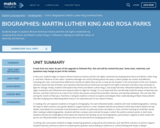
In this unit, students begin to explore African-American history and the civil rights movement by studying Rosa Parks and Martin Luther King Jr. and their influence on the nation. Students will begin the unit by thinking about the ways in which people are similar and different, including skin color, and how those differences should not define who we are or how we are treated. In the second part of the unit, students will learn about the discrimination and injustices faced by African-Americans during the civil rights movement and why it was necessary to fight for change. Finally, students will explore Rosa Parks and Martin Luther King Jr. and study how their influential leadership drove the civil rights movement and influenced and inspired others to fight for change. It is our hope that this unit will help instill the values of diversity and fairness, and that it will serve as a launch for further discussions around discrimination, fairness, and valuing individuals. This unit also falls during the month of February. Therefore, it will give students a chance to explore and deepen their understanding of Black History Month and why studying and celebrating black history is an important part of our nation's history.
In reading, this unit exposes students to the genre of biography. For each influential leader, students will read multiple biographies, noticing the ways in which authors use specific details to support points in a text. Students will also be pushed to think about which details are key details, how details are connected, how illustrations connect to particular points and ideas in a text, and the meaning of unfamiliar words. After reading multiple biographies, students will then compare and contrast the ways in which the authors present points in both texts. Students will also be challenged to think about the themes that develop across the biographies, particularly in regards to what makes the person an influential leader and the lessons that can be learned from studying each person.
In writing, this unit pushes students to begin answering questions using words and sentences, and, therefore, rely less on picture support. Students will also continue to work on answering the question and including an inference or critical thinking that shows a deeper understanding of the text. At this point, all structure focus correction areas should be taught; therefore, the focus of this unit should be on providing individualized feedback to students who are not at a 3 or 4 on the rubric.
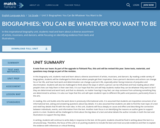
In this biography unit, students read and learn about a diverse assortment of artists, musicians, and dancers. By reading a wide variety of biographies, students will be challenged to think about where people get their inspiration, how a person's decisions and actions can change his or her life, and how hard work and determination can change a person's life, especially when facing instances of prejudice and discrimination. Students will also be challenged to think about the ways in which a person can be influential and how reading about other people's lives can help them in their own lives. It is our hope that this unit will help students realize they can be whatever they want to be if they are determined and work hard, and that no obstacle, no matter how big it may feel, can stop someone from achieving something they are determined to achieve. It is also our hope that this unit will open students' eyes to different life paths and passions, particularly those in the arts.
In reading, this unit builds onto the work done in previously informational units. It is assumed that students are inquisitive consumers of an informational text, asking and answering questions about key details. It is also assumed that students are able to find the main topic of a text and retell key details that fit with the main idea. In this unit, students will focus deeply on cause and effect and describing the connection between individuals, events, and information from the text. Another main focus is on identifying the reasons an author gives to support points in a text. Students will be challenged to think about the big ideas of a text and what details the author includes in both the text and illustrations to support the key ideas.
In writing, students will continue to write daily in response to the text. At this point, students should be fluid in writing about the text in a structured way. Therefore, the focus of this unit is on pushing students to include the best and most accurate evidence and then to explain the evidence with inferences or critical thinking.

This science and math lesson uses coated candy and water to create a rainbow on a plate. It takes a popular internet activity and modifies it for the classroom. It's extended by having students hypothesize if other temperatures of water will work and if different colors of the candies run faster than others. It also meets the math SOLs because students can calculate the cost of the experiment and/or create graphs of the results of the experiments. You could extend this activity into art or English writing by having students draw their rainbows or write about what they saw happening on the plate as a report writing. You could have them take it a step further and do a creative writing about what they think is at the other end of the rainbow.

Section 1 -Children will answer questions and learn vocabulary while enjoying Little Red Riding Hood.Section 2 - Children will build confidence as writers by watching this teacher as she writes about the theme of kindness from Little Red Riding Hood. This video would be a good introduction to the student's own writing about the story.Section 3 - Children will enjoy a retelling of the story, then work on identifying the beginning, middle, and end of the text.Section 4 - Children will build confidence as writers by watching this teacher draw and write about the character of the wolf. This video would be a good introduction to the student's own writing about a story character.
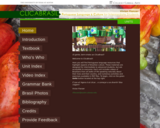
The Portuguese language lessons of ClicaBrasil highlight aspects of Brazilian culture. They are designed for intermediate to advanced students, but are accessible to everyone. Each lesson includes videos of Brazilians from all walks of life speaking naturally about their lives and their country. All lessons integrate reading, writing, listening and comprehension, grammar, vocabulary, oral communication and cultural activities with the videos. This is also available as a free PDF textbook and as print on demand.